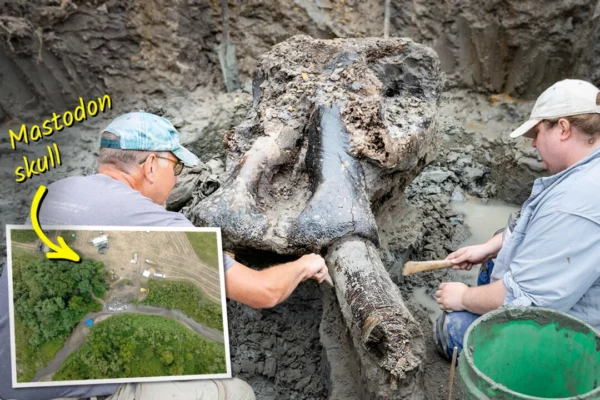Recently, archaeologists in Iowa, USA unearthed a well-preserved prehistoric mastodon skull dating back to 13,600 years ago in a small stream, marking the first discovery of such fossil in the state.
According to a press release from the University of Iowa, two years ago in 2022, a resident from Wayne County in southern Iowa called the Office of the State Archaeologist (OSA) at the University of Iowa, reporting an unusually long bone found on the riverbed of a remote creek in the southwest of Wayne County. They were uncertain about the species it belonged to.
The OSA swiftly assembled an archaeological team to investigate the site. They soon identified the fossil as the femur (commonly known as thigh bone) of an extinct giant mastodon, much to the excitement of the archaeologists.
Mastodons, related to modern elephants and mammoths, were large mammals that went extinct approximately 10,000 years ago. They inhabited forests worldwide, with a primary distribution in North and Central America, standing up to 9 to 10 feet (2.7 to 3 meters) tall and weighing up to 6 tons.
Shortly after, through further on-site surveys, the team discovered a broken piece of tusk protruding from the riverbed, speculating that there might be a connected skull buried in the sediment, indicating the necessity for a formal and thorough scientific investigation.
After securing sufficient research funding, the team returned to the site in August of this year. Through careful excavation, a huge and well-preserved mastodon skull along with several other skeletal fragments were unearthed, leading researchers to preliminarily conclude that all these remains likely originated from the same animal.
Subsequent radiocarbon dating identified that these skeletal remains date back 13,600 years. This research suggests the likelihood that this large prehistoric animal coexisted with the earliest Native Americans who inhabited the region, therefore increasing the potential for interactions between humans and these animals.
It is widely believed that the first humans to set foot on the North American continent arrived between 13,000 and 13,500 years ago, migrating on foot from Siberia through the Bering Land Bridge and eventually reaching Alaska. They possibly hunted mastodons for meat and hide.
“We truly hope to find evidence of human interaction with this species, such as projectile points or tools used for hunting and butchering animals,” stated John Doershuk, director of the OSA and archaeologist involved in the excavation, in the press release. “The bones themselves could also hold potential evidence, such as identifiable cut marks.”
The team noted the discovery of some human-made artifacts around the site, including stone tools dating back thousands of years.
Doershuk expressed that finding such a well-preserved and ancient mastodon skull is exceptionally rare and referred to this discovery as a “biological data treasure trove” regarding the species.
Further archaeological research is needed to uncover how and why this mastodon ended up buried in this riverbed, as well as the interactions between early humans and this species.

